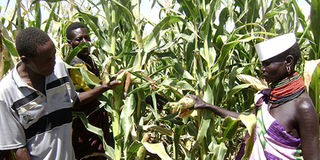Deadly maize disease to cut output in key bread basket

Members of Kaplokor smallholder irrigation scheme in Turkana South District, admiring a maize crop. Maize production could drop on depressed rains and disease attack.
What you need to know:
- Maize production is set to decline further after the government distributed more than 70 metric tonnes of orphan crop seeds worth Sh10.4 million in South Rift region to be planted as an alternative to maize.
Maize production is expected to decline in the Rift Valley this season due to increased fuel prices and fears over the return of a deadly disease.
Agriculture ministry says depressed rainfall has also affected planting in parts of the South Rift region.
“Maize planting for the 2013 long rain season has been slow. Few farmers have planted with very low acreage achieved,” the annual crop production report says.
The report reveals that only 100,000 hectares out of the possible 665, 000 hectares in the vast region has been planted with maize, and 20,000 out of 256,000 hectares with beans.
Crop rotation
Maize production is set to decline further after the government distributed more than 70 metric tonnes of orphan crop seeds worth Sh10.4 million in South Rift region to be planted as an alternative to maize.
The crops include sorghum, finger millet, beans, green-grams and cowpeas.
This is to stop the spread of the deadly maize lethal necrosis (MLN) that wiped out the crop in the region.
The disease can only be stopped by crop rotation and farmers in Bomet, Sotik and Narok districts will have to plant the orphan crops this season and only plant maize later.
The resurgence of the disease that destroyed several hectares of maize last season has been reported by farmers in South Rift, who planted their maize crop in November.
Maize production in Rift Valley dropped by 4 million bags — from 21 million to 17 million bags last season partly due to the outbreak of the disease.
In addition to the disease, farmers in the region have warned that the rise in fuel prices may reduce maize acreage.
Early this year, the Energy Regulatory Commission raised the price of diesel by Sh2.21 a litre. Last week, the same quantity went up by Sh1.17 such that farmers are now paying Sh2,500 to plough an acre of maize, up from Sh2,300.
“Normally, when the price of fuel goes up, it affects even that of lubricants. This year, it has increased twice, forcing us to increase ploughing charges by a bigger margin,” Trans-Nzoia County tractor-owner Peter Kimutai said.
Reported by Barnabas Bii, Raphael Wanjala and Gerald Andae




